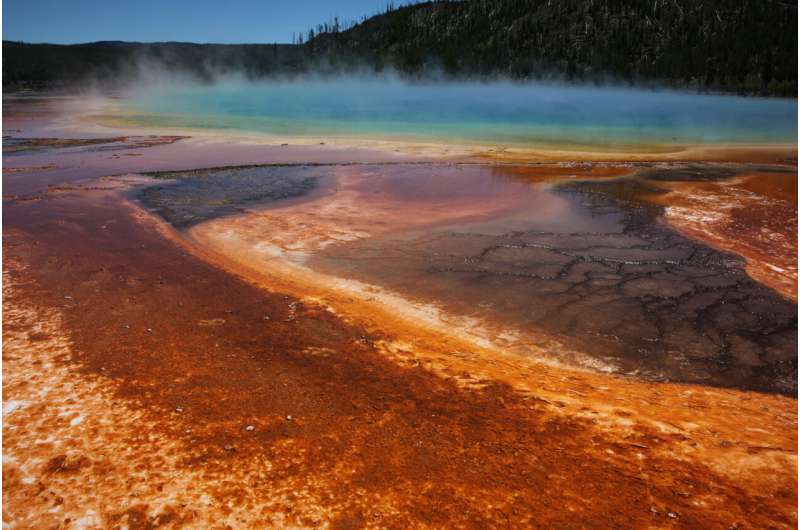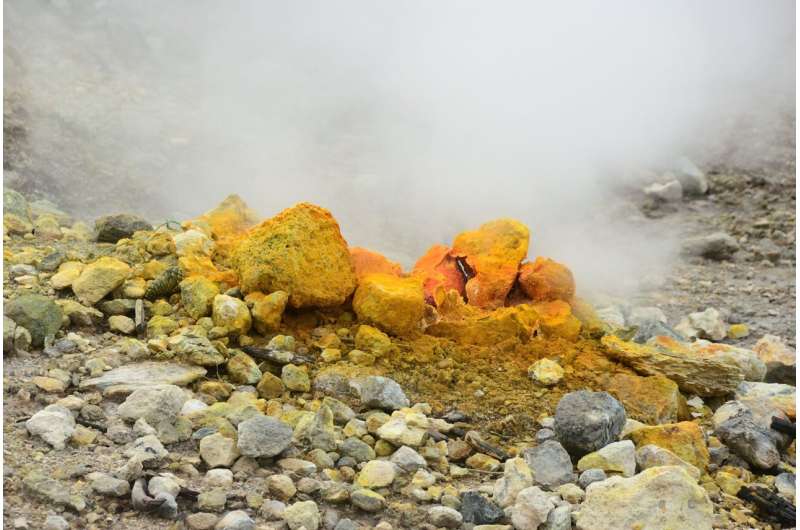Extremophiles could hold clues for climate change-tackling technologies

Microscopic organisms known as extremophiles inhabit some of the last places on Earth you might expect to find life, from the extreme pressures of the ocean floor to freezing ice caps. Understanding how these microbes survive by interacting with different metals and gases is opening up new knowledge about Earth's elements and their potential uses.
One such extreme habitat is mud volcanoes—typically cone-shaped structures or pools that discharge bubbling mud, as well as steam and gases like methane and carbon dioxide.
More than 1,000 mud volcanoes, which are often associated with so-called subduction zones, where one tectonic plate is forced under another, and can be extremely acidic, have so far been found on or near land.
Some researchers have been looking to find out more about the microbial communities these mud volcanoes contain and their role in cycling gases and other elements, including methane, hydrogen, ammonia and sulfur.
In Italy, a project called VOLCANO investigated microbes that live in highly acidic mud pools in the crater of the dormant Solfatara volcano near Naples and on a volcanic island off northern Sicily called Vulcano, which originally gave its name to the word 'volcano' and is famous for its mud baths and hot springs.
Professor Huub Op den Camp, a microbiologist at Radboud University in Nijmegen, the Netherlands, and principal investigator on VOLCANO, says the researchers 'serendipitously' discovered a third exploration site—the volcanic island of Pantelleria, west of Sicily. This came when they ran into other researchers who had found molecular evidence suggesting Pantelleria's hot, acidic soil contained bacteria related to those in the mud pools and involved in cycling the same gases.
These habitats, as a significant source of the powerful greenhouse gas methane, are now providing valuable clues to climate change, as well as having potential applications in green technologies such as biofuels and recycling metals in electronic devices.
Rare earth elements
One of the key inspirations for VOLCANO was linked to so-called rare earth elements (REEs), a group of 17 chemically similar metallic elements that are in fact abundant in Earth's crust despite their name.
Earlier, Prof. Op den Camp's team had discovered that REEs were an essential part of metabolism in Methylacidiphilum fumariolicum SolV, an acid-loving microbe found in a Solfatara mud volcano that can live at extreme pH levels below 1 and gets its energy from the consumption—or oxidation—of methane.
It was the first time REEs were identified as a condition for life in an organism, after previously being thought not to be involved in biological processes. Cerium, the most abundant of 15 REEs known as lanthanides, appeared to be foremost in stimulating growth among several the researchers tested.
"It was a metal completely unknown to be active in life. We found out that there is an enzyme (a biological catalyst) in these bacteria that contains this metal as a co-factor, and without this lanthanide the organism cannot function," said Prof. Op den Camp. He says their discovery about REEs has led to a 'booming field of research' on such processes in extremophiles.
It has also become apparent that use of REEs among bacteria in general is much more common than previously thought, including in non-mud-volcano habitats. Prof. Op den Camp's team found, for example, that two novel methane-oxidizing organisms from North Sea sediments contained enzymes dependent on lanthanides, while a review they carried out highlighted the growth in research using REEs to cultivate microbes previously considered uncultivable.
Apart from working out how to grow such microbes in the lab, the findings help to discover new ones. "Now, more and more people are isolating bacteria that are strictly dependent on lanthanides," said Prof. Op den Camp.
Applications
All this potentially has many uses. If we can learn how to isolate large amounts of these elements from bacteria, we could use this knowledge to extract and recycle metals from mobile phones and other electronic devices, which contain REEs such as cerium, lanthanum and neodymium. This may be useful in the long term because these elements are difficult to mine and extract economically, as well as being finite.
Being able to manipulate lanthanides could also aid production of environmentally friendly biogas, such as green methanol. During cultivation of M. fumariolicum, the researchers were able to produce methanol from methane by restricting lanthanides as an input that would otherwise help transform the methanol into formaldehyde.
Meanwhile, the team found that the same bacterium can scavenge the tiny trace amounts of hydrogen gas from the atmosphere—where it is present at just 0.5 parts per million gas molecules—to use as an energy source in addition to methane. Prof. Op den Camp says the extra energy gained from hydrogen could help the bacteria oxidize more methane.
"Maybe both metabolisms (of hydrogen and methane) help each other also to trap very low concentrations of these gases," he said, raising questions about how far they can go in removing trace gases from the atmosphere.

It also bolsters evidence that microbial metabolism of molecular hydrogen is much more common than originally thought, giving more clues to the hydrogen cycle on Earth. Furthermore, with hydrogen being explored as a key green fuel of the future, Prof. Op den Camp says this could eventually help in driving a 'hydrogen economy' if the gas can be isolated from the microbes by reversing the activity of hydrogenase, the bacterium's hydrogen-eating enzyme.
His team also speculatively calculated whether the bacteria could be used in filters to reduce methane from cows—major emitters of the gas. However, they worked out that with current technology, the filter's size would have to be too large to be feasible.
And Prof. Op den Camp also emphasizes that many applications for mud-volcano extremophiles could be a long way off, with challenges in upscaling such activity. "You can think of applications, but that's a bit far away still," he said. "It also will cost a lot of money to take to a large scale."
But while many applications may take a while, Prof. Op den Camp says the research all contributes to gradually improving understanding of fundamental gas cycles on Earth that aid our knowledge of the climate. "This kind of information is important for future understanding of the cycling of elements that influence the climate," he said.
Such extreme habitats are also useful to study because their relatively low biodiversity makes them less complex than other ecosystems, explains Prof. Op den Camp—though even this may be less simple than originally thought. "They still bring big surprises," he said. "In the Pantelleria soil, we also found methane-producing bacteria, which we didn't expect at all."
Harsh conditions
Dr. Anna Krüger, a consultant in genetic engineering at the Authority for the Environment, Climate, Energy and Agriculture in Hamburg, Germany, has carried out research into extremophiles in places including Vulcano. She says her former team at the Hamburg University of Technology was 'surprised' by how many different groups of species they could detect by sequencing DNA from places such as hot springs and mud volcanoes.
She says that the enzymes, or 'extremozymes," found in such microbes are promising due to their ability to withstand the types of harsh conditions often found in industrial processes and have the potential to help develop biocatalysts for use in everyday life, such as in washing detergents.
"Biotechnology is one key aspect towards changing our economy from resource-consuming oil-based to a sustainable bio-based community," she added.
Knowing more about, for example, microbes that like extreme heat, would widen the opportunities, says Dr. Krüger. "I think it will be an important step to analyze community dynamics and understand complete metabolic interactions," she said. "This would then enable the design of tailor-made extreme species for the production of all sorts of chemicals, medicals, antibiotics and bioplastics at elevated temperatures."
She also pointed to a heat-resistant enzyme originally isolated from bacteria in the hot springs of Yellowstone National Park that has been key during the COVID-19 pandemic. "Most prominent is still Taq polymerase, which enabled the polymerase chain reaction (PCR), the gold standard of our current SARS-CoV-2 testing," she said.
Professor Alexandre Soares Rosado, an environmental microbiologist at King Abdullah University of Science and Technology in Thuwal, Saudi Arabia, also sees organisms that have needed to adapt to thrive in places where life has been pushed to its limits as holding promise for applications in biotechnology and sustainable development.
He views extremophiles as potentially providing more sustainable applications in sectors with a predicted surge in demand for enzymes, such as food and drink, biofuels and animal feed.
"Only recently did we start to understand and have better tools to unravel the diversity of extremophiles worldwide," said Prof. Rosado, who is investigating harsh habitats in Saudi Arabia such as active and inactive volcanoes, deserts and geothermal sites. "As a consequence, there is a huge potential for biotechnological applications in the real world."
Mud volcanoes
Meanwhile, mud volcanoes themselves can help us understand unique ecosystems tightly linked with the plumbing of gases, fluids and sediments from fracture networks that often extend several kilometers down, says Dr. Pei-Ling Wang, a geochemist at the National Taiwan University in Taipei.
They can also bring fundamental knowledge about the climate cycle, she adds. "Microbial power in the bubbling mud pools or cone structures and surrounding mud platforms is critical to regulating the flux of greenhouse gases," said Dr. Wang.
"Methanotrophs (microbes that metabolize methane) living in terrestrial mud volcanoes are critical players for methane consumption. Understanding their physiology, capabilities and distribution can establish a model for their role in greenhouse gas regulation."
More information: Bram Vekeman et al, Genome Characteristics of Two Novel Type I Methanotrophs Enriched from North Sea Sediments Containing Exclusively a Lanthanide-Dependent XoxF5-Type Methanol Dehydrogenase, Microbial Ecology (2016). DOI: 10.1007/s00248-016-0808-7
Provided by Horizon: The EU Research & Innovation Magazine





















